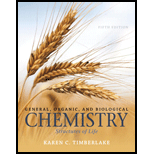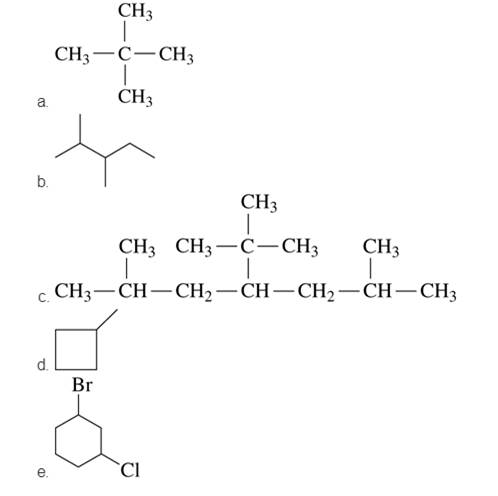
General, Organic, and Biological Chemistry: Structures of Life (5th Edition)
5th Edition
ISBN: 9780321967466
Author: Karen C. Timberlake
Publisher: PEARSON
expand_more
expand_more
format_list_bulleted
Concept explainers
Textbook Question
Chapter 12.3, Problem 12.15QAP
Give the IUPAC name for each of the following:

Expert Solution & Answer
Want to see the full answer?
Check out a sample textbook solution
Students have asked these similar questions
An einstein is the amount of energy needed to dissociate 1 mole of a substance. If we have 0.58 moles, do we need 0.58 einsteins to dissociate that substance?
If the energy absorbed per mole of gas is 480 kJ mol-1, indicate the number of Einsteins per mole.Data: Energy of each photon: 0.7835x10-18 J.
If the energy absorbed per mole of gas is 480 kJ mol-1, indicate the number of Einsteins per mole.
Chapter 12 Solutions
General, Organic, and Biological Chemistry: Structures of Life (5th Edition)
Ch. 12.1 - Identify each of the following as a formula of an...Ch. 12.1 - Prob. 12.2QAPCh. 12.1 - Prob. 12.3QAPCh. 12.1 - Prob. 12.4QAPCh. 12.1 - Prob. 12.5QAPCh. 12.1 - Prob. 12.6QAPCh. 12.1 - Prob. 12.7QAPCh. 12.1 - Prob. 12.8QAPCh. 12.2 - Give the IUPAC name for each of the following...Ch. 12.2 - Prob. 12.10QAP
Ch. 12.2 - Prob. 12.11QAPCh. 12.2 - Prob. 12.12QAPCh. 12.3 - Prob. 12.13QAPCh. 12.3 - Prob. 12.14QAPCh. 12.3 - Give the IUPAC name for each of the following:Ch. 12.3 - Give the IUPAC name for each of the following:Ch. 12.3 - Draw the condensed structural formula for each of...Ch. 12.3 - Draw the condensed structural formula for each of...Ch. 12.3 - Draw the line-angle structural formula for each of...Ch. 12.3 - Draw the line-angle structural formula for each of...Ch. 12.4 - Heptane, used as a solvent for rubber cement, has...Ch. 12.4 - Nonane has a density of 0.79 g/mL and boils at 151...Ch. 12.4 - Prob. 12.23QAPCh. 12.4 - Prob. 12.24QAPCh. 12.4 - Prob. 12.25QAPCh. 12.4 - Prob. 12.26QAPCh. 12.5 - Prob. 12.27QAPCh. 12.5 - Prob. 12.28QAPCh. 12.5 - Prob. 12.29QAPCh. 12.5 - Prob. 12.30QAPCh. 12.5 - Prob. 12.31QAPCh. 12.5 - Prob. 12.32QAPCh. 12.6 - 12.33 Give the IUPAC name for each of the...Ch. 12.6 - Prob. 12.34QAPCh. 12.6 - Prob. 12.35QAPCh. 12.6 - Prob. 12.36QAPCh. 12.6 - Prob. 12.37QAPCh. 12.6 - Prob. 12.38QAPCh. 12.7 - Prob. 12.39QAPCh. 12.7 - Prob. 12.40QAPCh. 12.7 - Prob. 12.41QAPCh. 12.7 - Prob. 12.42QAPCh. 12.7 - Prob. 12.43QAPCh. 12.7 - Prob. 12.44QAPCh. 12.7 - Prob. 12.45QAPCh. 12.7 - Prob. 12.46QAPCh. 12.8 - Prob. 12.47QAPCh. 12.8 - Give the IUPAC name and any common name for each...Ch. 12.8 - Prob. 12.49QAPCh. 12.8 - Prob. 12.50QAPCh. 12.8 - Prob. 12.51QAPCh. 12.8 - Prob. 12.52QAPCh. 12.8 - Prob. 12.53QAPCh. 12.8 - Prob. 12.54QAPCh. 12 - Prob. 12.55UTCCh. 12 - Prob. 12.56UTCCh. 12 - Prob. 12.57UTCCh. 12 - Prob. 12.58UTCCh. 12 - Prob. 12.59UTCCh. 12 - Prob. 12.60UTCCh. 12 - Prob. 12.61UTCCh. 12 - Prob. 12.62UTCCh. 12 - Give the number of carbon atoms and the types of...Ch. 12 - Prob. 12.64UTCCh. 12 - Prob. 12.65AQAPCh. 12 - Give the IUPAC name for each of the following:...Ch. 12 - Prob. 12.67AQAPCh. 12 - Prob. 12.68AQAPCh. 12 - Prob. 12.69AQAPCh. 12 - 12.70 Give the IUPAC name for each of the...Ch. 12 - Prob. 12.71AQAPCh. 12 - Prob. 12.72AQAPCh. 12 - Prob. 12.73AQAPCh. 12 - Prob. 12.74AQAPCh. 12 - Prob. 12.75AQAPCh. 12 - Prob. 12.76AQAPCh. 12 - Prob. 12.77AQAPCh. 12 - Prob. 12.78AQAPCh. 12 - Prob. 12.79AQAPCh. 12 - Prob. 12.80AQAPCh. 12 - Prob. 12.81AQAPCh. 12 - Prob. 12.82AQAPCh. 12 - Prob. 12.83AQAPCh. 12 - Prob. 12.84AQAPCh. 12 - Prob. 12.85AQAPCh. 12 - Prob. 12.86AQAPCh. 12 - Prob. 12.87AQAPCh. 12 - Prob. 12.88AQAPCh. 12 - Prob. 12.89CQCh. 12 - Prob. 12.90CQCh. 12 - Prob. 12.91CQCh. 12 - Prob. 12.92CQCh. 12 - Prob. 12.93CQCh. 12 - Prob. 12.94CQ
Knowledge Booster
Learn more about
Need a deep-dive on the concept behind this application? Look no further. Learn more about this topic, chemistry and related others by exploring similar questions and additional content below.Similar questions
- The quantum yield of the photochemical decay of HI is 2. Calculating the moles of HI per kJ of radiant energy can be decayed knowing that the energy absorbed per mole of photons is 490 kJ.arrow_forwardThe quantum yield of the photochemical decay of HI is 2. Calculate the number of Einsteins absorbed per mole knowing that the energy absorbed per mole of photons is 490 kJ.arrow_forwardThe quantum yield of the photochemical decay of HI is 2. How many moles of HI per kJ of radiant energy can be decayed knowing that the energy absorbed per mole of photons is 490 kJ.arrow_forward
- If the energy absorbed per mole of photons is 450 kJ, the number of Einsteins absorbed per 1 mole.arrow_forwardWhen propionic aldehyde in vapor form at 200 mmHg and 30°C is irradiated with radiation of wavelength 302 nm, the quantum yield with respect to the formation of CO is 0.54. If the intensity of the incident radiation is 1.5x10-3 W, find the rate of formation of CO.arrow_forwardDraw mechanismarrow_forward
- Does Avogadro's number have units?arrow_forwardExplain why the total E in an Einstein depends on the frequency or wavelength of the light.arrow_forwardIf the dissociation energy of one mole of O2 is 5.17 eV, determine the wavelength that must be used to dissociate it with electromagnetic radiation. Indicate how many Einstein's of this radiation are needed to dissociate 1 liter of O2 at 25°C and 1 atm of pressure.Data: 1 eV = 96485 kJ mol-1; R = 0.082 atm L K-1; c = 2.998x108 m s-1; h = 6.626x10-34 J s; NA = 6.022x 1023 mol-1arrow_forward
- Indicate the number of Einsteins that are equivalent to 550 kJ mol⁻¹ of absorbed energy (wavelength 475 nm).arrow_forwardIndicate the number of einsteins that are equivalent to 550 kJ mol⁻¹ of absorbed energy?arrow_forwardA unit used in photochemistry is the einstein. If 400 kJ mol-1 of energy has been absorbed, how many einsteins is this equivalent to?arrow_forward
arrow_back_ios
SEE MORE QUESTIONS
arrow_forward_ios
Recommended textbooks for you

 Chemistry for Today: General, Organic, and Bioche...ChemistryISBN:9781305960060Author:Spencer L. Seager, Michael R. Slabaugh, Maren S. HansenPublisher:Cengage Learning
Chemistry for Today: General, Organic, and Bioche...ChemistryISBN:9781305960060Author:Spencer L. Seager, Michael R. Slabaugh, Maren S. HansenPublisher:Cengage Learning General, Organic, and Biological ChemistryChemistryISBN:9781285853918Author:H. Stephen StokerPublisher:Cengage Learning
General, Organic, and Biological ChemistryChemistryISBN:9781285853918Author:H. Stephen StokerPublisher:Cengage Learning Organic And Biological ChemistryChemistryISBN:9781305081079Author:STOKER, H. Stephen (howard Stephen)Publisher:Cengage Learning,
Organic And Biological ChemistryChemistryISBN:9781305081079Author:STOKER, H. Stephen (howard Stephen)Publisher:Cengage Learning,


Chemistry for Today: General, Organic, and Bioche...
Chemistry
ISBN:9781305960060
Author:Spencer L. Seager, Michael R. Slabaugh, Maren S. Hansen
Publisher:Cengage Learning

General, Organic, and Biological Chemistry
Chemistry
ISBN:9781285853918
Author:H. Stephen Stoker
Publisher:Cengage Learning

Organic And Biological Chemistry
Chemistry
ISBN:9781305081079
Author:STOKER, H. Stephen (howard Stephen)
Publisher:Cengage Learning,
Nomenclature: Crash Course Chemistry #44; Author: CrashCourse;https://www.youtube.com/watch?v=U7wavimfNFE;License: Standard YouTube License, CC-BY